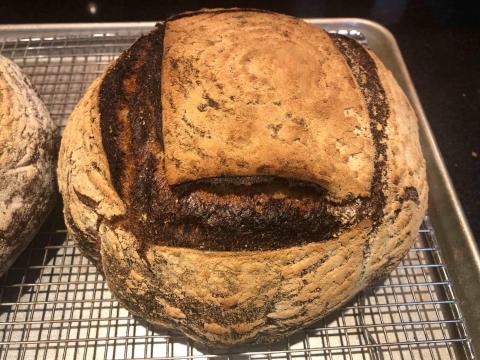 JerrytheK
JerrytheKFirst Attempt Poilâne-style Sourdough

This is a follow up to a previous post asking if anyone had ever tried the Poilâne-style sourdough bread.
No one had, someone suggested I try it, and here's my results.
I've posted the full recipe from the book Poilâne.
For the most part, because this was a first attempt, I followed the recipe as closely as I could.
Because you can refer to the recipe in the pictures, I'll just mention how I varied from the recipe and some other details.
I used Whole Foods Everyday 365 WW flour and Central Milling's Organic Unbleached AP Flour (from Costco).
Regular tap water.
Non-fat Greek yogurt (all that was available at the time!).
The first rise after mixing called for :45. Very little rise occurred. I kicked up the temperature from 23C/73F to 28C/82F for another :20 + :10 for a total time of 1:15.
The final mix weighed 2103g and was to be baked in a 12" cast iron pot. I only have 8 quart dutch ovens, so I divided the dough into two loaves and put them into floured baskets. I'm awaiting linen liners, so I had to skip those too.
The second rise was to take 2:00, but the dough seemed to be ready at about 1:45.
Baked in a 465F convection oven, first :10 covered, then just :40, rather than :45 more. I baked it to an internal temp of 201F/94C. As I'm at about 5,400' above sea level, that's as hot as any bread I've baked can reach.
As you can see, the bread has fairly tight crumb. Somewhere in the book she mentions that their style produces tighter crumb than one usually expects.
Taste was good, but not that 'sourdoughish'.
Would I try this again?
Yes, but here's what I'd change. It was a fun exercise making a dough that needed to be kneaded (and who says English isn't a difficult language to learn?!) and a departure from the regular break-baking routine.
Kick up the hydration. I'm in Colorado, and our ingredients are very dry, because of the low relative humidity, particularly in the winter. The starter's hydration (ignoring the yogurt) is about 76% and the dough is about 65%. I'd kick up the dough to about 70% next time.
For the first rise, I'd lightly grease the bowl with olive oil. The dough was sticky and a bit difficult to cleanly get out of the bowl.
I might also add a bit of time (judging at the time on the condition of the rise) for the second rise.
After another try with the standard ingredients, I may also make it using home-milled whole wheat flour.
I'd appreciate any comments, suggestions or criticisms.
p1.jpg

P2.jpg

P3.jpg

P4.jpg

PB1.jpg

PB2.jpg

Share
Comments
 idaveindyMarch 22, 2020 - 2:30pmCool!
idaveindyMarch 22, 2020 - 2:30pmCool!
I knew yogurt has LAB, but does it have wild yeast? Or is this a "LAB only" "starter"?
I see the active dry yeast for the final dough in the recipe. But that doesn't seem enough to raise that much dough so quickly, so I suspect it is just for speed.
It looks like you got excellent vertical rise. What is the diameter of those loaves?
 JerrytheKMarch 22, 2020 - 2:38pmDiameter
JerrytheKMarch 22, 2020 - 2:38pmDiameter
It must only be a LAB-only starter.
I didn't expose the Cambro to the open air as one normally would when starting a starter.
The diameter at the bottom is about 8 ¼"/21 cm.
At the :10 mark when baking, when the recipe calls for uncovering the dutch oven, the loaf had achieved all or nearly all of its height.
You can still edit this post, and copy/paste the other into here. It will get more exposure here than in a blog.
Thanks. Done.
But it's not really sourdough, is it?
I think people's disappointment in the book stems from a misunderstanding of the author's target audience.
The author/publisher also sort of mislead, or created that misunderstanding by sub-titling the book "Secrets of the World-famous Bread Bakery" when in fact (according to reports, I haven't read it) the recommended "home baker short cuts" fall short of artisan techniques. It was more of a "tease".
A lot of editorial decisions and almost all cover design is up to the publisher (from what I gather from listening to authors), so it's not all the author's "fault" for the misleading sub-title.
I hope to pick up a used copy when the prices drop, or get the Kindle edition if it goes on sale $5 or under.
I agree on waiting for a used/remaindered copy or a kindle edition.
Although the bread is OK, the rest of the book is quite good.
Tells the story of the bakery (now empire), her parents' death, her taking over the business as a Harvard student!, and recipes with bread.
Just checked and read some reviews. current new price is $19 and change, MSRP $35. (free ship for Prime and orders over $25).
One reviewer says the starter (initiated with yogurt) does eventually turn into a sourdough starter as time goes on. Seems natural, especially if you feed it some whole wheat as per instructions. And when it does, you don't need the commercial yeast in the final dough, per the reviewer.
I may buy a copy just to own part of the history, and have such a famous family and bread dynasty in my library, an homage to the Poilanes. The Poilanes, starting with the grand-dad, put their_soul_ into it.
I'm getting to be sort of like how Peter Reinhart was early on, with all that spiritual stuff about, dough/baking/bread.